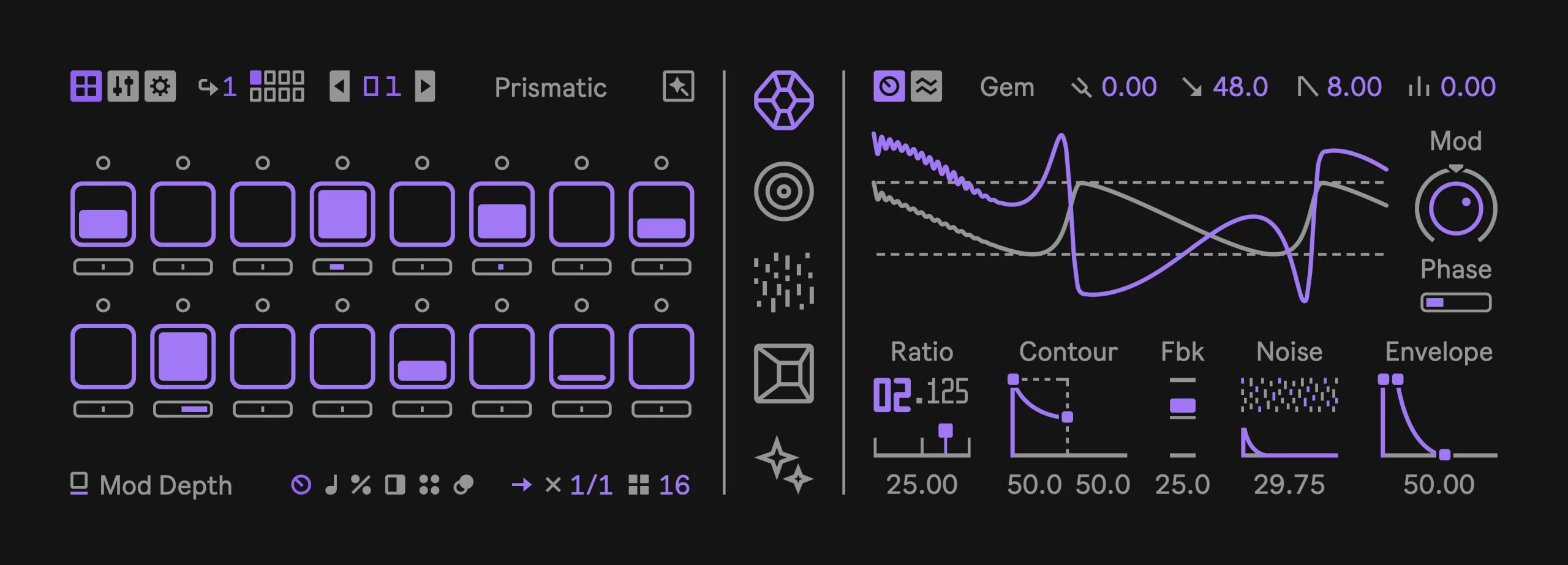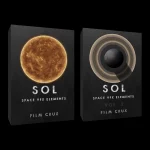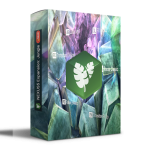Fors Opal v1.3 Ableton Max for Live AMXD ALP
Rhythm machine
Opal is an instrument made for intricate pattern creation. With parameter locks, probability, conditionals, ratcheting, independent track length, time division and traversal, it’s a breeze to program exciting patterns.
Drum synthesizer
Opal comes with four distinct, highly malleable, synthesizers and two sequenceable effects. While the synths are tailored for creating drum sounds, it’s up to you to choose where, or if, the line between percussion and melody is drawn.
Meet the engines:
Gem FM Synth
Gem is an FM synthesizer capable of a wide variety of sounds, from deep and heavy bassdrums to glistening lead melodies. At its core, Gem consists of 2- Operator sinewave-based phase modulation (commonly referred to as FM) that has been fine-tuned to sound rich and punchy.
With bipolar modulation and feedback, it’s possible make a vast range of different waveshapes- including common analog shapes such as square, triangle or sawtooth. It’s a highly malleable form of synthesis that has been boiled down to its essentials, with an emphasis on the sheer quality of execution.
Mass Modal Synth
Mass is a modal synthesizer, which is a type of physical modeling synthesis that employs a bank of bandpass filter to generate its sound. Typically, physical modeling is used to mimic real-world sounds, but with Mass the essence of the synthesis method is used to make all sorts of wildly synthetic sounds, often with an otherworldly quality due to its physically-inspired origins.
The sounds possible with Mass ranges from semi-realistic percussion, bells, textures, noises, strange phase-y melodic sounds to clean and precise timbres reminiscent of additive synthesis.
Dust Pulsar Synth
Dust is a noise generator that is based around the concept of Pulsar synthesis, which is a method adjacent to Granular synthesis. The sound is composed of very short particles of sounds that creates a texture when played fast and/or dense.
Dust combines concepts from all kinds of different types of synthesis methods to create anything from pure white noise to perfectly soft spectral washes. By layering multiple oscillators Dust can also generate classic electronic metal sounds which is very useful for making hi-hats and cymbals.
Slate Grain Sample
Slate is a sample playback engine equipped with a granular mode that can wildly transform any sample. At its core is a high quality sample playback engine with edge smoothing (click-less playback and looping), single cycle waveform support and a flexible loop mode.
The granular mode let’s you go deeper in sound design by playing back small particles in a pattern that essentially reconstructs the original sound, but with the possibility to dramatically change the speed and pitch independently.
Void & Flux FX
The FX (effects) track hosts two different effect engines: Void and Flux.
Void is a reverb that has been fine-tuned to sound great with a wide variety of input sounds, with an emphasis on delivering good transient response. With in-depth EQ:ing of the input and reverb signal, it’s possible to greatly shape the overall tone of the effect.
Flux is an automatic sampler that continuously records the output of all the other tracks and divides it into 16 slices that can be played back by the FX track. Think of it like an always-recording tape loop that you can use to repeat or transform sections of your pattern by playing different snippets as single shot samples.
Modulation
Each engine has a dedicated modulation page with four different modulation sources that can be routed to any parameter via a modulation matrix. The different sources are Vel – velocity received from the sequencer steps (or a MIDI note), A dedicated LFO and Envelope per track, and a random value (Rand) that is received on each trigger of a step or MIDI note.
Sequencer Modulation:
Parameter
Parameter locks allow you to set a unique value for any synthesizer parameter on each step in the sequencer. This is a powerful method which essentially allows you to have a unique sound on every step.
Note
Note locks lets you program a melody, or simply just change the pitch of every step. When you place a new trig, it has the default note value which can be changed for a quick transposition of all non-locked trigs.
Probability
Probability sets a random percentage chance that a step will trigger or not, from 100% certain to 0. This can be used to introduce random variations and elements in a pattern.
Modulo
Modulo allows you to deteremine whether a step should trigger only on a count of a bar. For example, 1:2 would mean that the step will only trigger on every second loop of the pattern. This lets you create structured variation in a pattern without changing the length.
Ratchet
Ratchet sets how many times a step is repeated up to 8 times per step. Paired with a different time division and length on a track, this can be used to introduce flams, stutters, triplets and so on.
Nudge
Nudge lets you shift each step forward in time, off the grid and unquantized. This is useful for programming swing, shuffle, polyrhythms or to just add a specific groove to a track.
Opal feels right at home in the Ableton device rack as it does in its own window with up to 400% UI scaling
Each synth engine in Opal comes as a separate Max for Live device which you can sequence, automate and route however you want.
External sequencing
Opal-Ctl is the MIDI version of Opal and lets you control other devices and plug-ins in Ableton Live with Opal’s extensive sequencing capabilities and modulation. With 10 customizable controls you can map out your very own instrument with the right type of look for its controls.
If you ever run out of inspiration, Opal can generate random sounds, variations, sequences and even completely new and unique patterns. Let the machine surprise you.
And yes, you can choose your own hue for the accent color in Opal so you can bask in the glow of your favorite shade, hours on end.
To sum it up
Step-sequencer with:
Parameter locks
Probability
Step logic
Ratcheting
Microtiming
Per-track length
Per-track direction
Per-track time division
With 128 steps per track
Five tracks with:
Gem FM Synthesizer
Mass Modal Synthesizer
Dust Pulsar Noise Synthesizer
Slate Granular Sample Player
Void Reverb & Flux Sampler
+ Modulation
+ Randomizer
& individual outputs
What’s included:
1 × Opal Rhythm Machine
1 × Opal-Ctl MIDI Sequencer
1 × Mass Modal Synthesizer
1 × Dust Noise Synthesizer
1 × Slate Granular Rompler
1 × Void Reverb Effect
System requirements
Minimum:
Ableton Live Suite 10.1+
macOS 10.11.6, Intel i5, 4GB RAM
Windows 7, Intel i5, 4GB RAM
Recommended:
Ableton Live Suite 11+
macOS 12, M1, 8GB RAM
Windows 10, Intel i7, 8GB RAM
Opal is a collection of Max for Live devices only compatible in Ableton Live with either Suite or the Max for Live add-on.
Live 10 users may need to ensure that the Max runtime is at least 8.3.1
Homepage:-https://fors.fm/opal




![Sean Divine Vocal Chains SR v1.8 [UPDATED]](https://www.goaudio.net/wp-content/uploads/2025/10/Divine-Mixing-Vocal-Chains-SR-Updated-Box-Render-150x150.webp)



![Toontrack LATEST MIDI PACK [APRIL 2025]](https://www.goaudio.net/wp-content/uploads/2025/04/Toontrack-LATEST-MIDI-PACK-APRIL-2025-150x150.png?v=1745120673)
![Toontrack LATEST MIDI PACK [MARCH 2025]](https://www.goaudio.net/wp-content/uploads/2025/03/Toontrack-LATEST-MIDI-PACK-MARCH-2025-150x150.png?v=1743055485)

![Toontrack NEW RELEASED MIDI [FEB 2025]](https://www.goaudio.net/wp-content/uploads/2025/02/gandr-collage-3-150x150.jpg?v=1740710859)

![Toontrack LATEST RELEASES MIDI BUNDLE [DEC 2025]](https://www.goaudio.net/wp-content/uploads/2024/12/toontrck-2024-150x150.png?v=1733532112)




![Toontrack Hollowbody EBX [WIN+MAC]](https://www.goaudio.net/wp-content/uploads/2024/09/Toontrack-Hollowbody-EBX-150x150.png?v=1726103695)
![Toontrack LATEST RELEASES MIDI BUNDLE [SEP 2024]](https://www.goaudio.net/wp-content/uploads/2024/09/gandr-collage-11-150x150.jpg?v=1725764744)
![Blockbuster Sound Sand Dune & Mockingbird [BUNDLE]](https://www.goaudio.net/wp-content/uploads/2024/08/blockbuster-sound--150x150.png?v=1724378090)
![Blockbuster Sound Mermaids Sirens & Horror Pack [BUNDLE]](https://www.goaudio.net/wp-content/uploads/2024/08/Blockbuster-Sound-150x150.png?v=1723854097)







![Initial Audio XO – Heat Up 3 Expansion [WIN+MAC]](https://www.goaudio.net/wp-content/uploads/2022/10/XO-–-Heat-Up-3-Expansion--150x150.png?v=1666064730)


